Partners In Health
Through Partners In Health, Cummings Foundation was delighted to fund the construction of Butaro Ambulatory Cancer Center, Rwanda’s first and only outpatient infusion center. On August 20, 2013, the Center was dedicated with Bill and Joyce Cummings present, along with Dr. and Mrs. Arlan and Alice Fuller, representing Cummings Foundation.
Prior to traveling to Rwanda for this very special occasion, the Cummings, along with the Fullers, spent time at Victoria Falls, on the border of Zambia and Zimbabwe, including a swimming visit to Devils Pool, directly at the upper edge of the falls in the Zambezi River.
Serving outpatients, the ambulatory center complements the existing Butaro Cancer Centre of Excellence, which treats patients who require overnight hospitalization, and whose 24 beds are always full, as it is the only dedicated cancer center in the country. This new modern outpatient facility offers oncology consultations, a chemotherapy mixing facility for both inpatients and outpatients, patient support groups, IV chemotherapy administration for 10 to 12 persons, family education, and counseling.
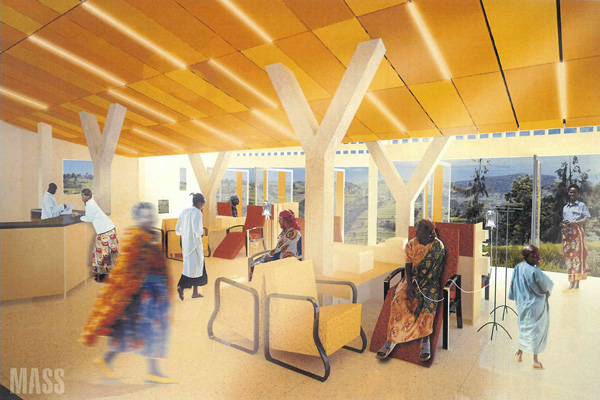

The Center is located in rural Burera District. When asked the reason for the location, Dr. Paul Farmer, co-founder of Partners In Health said, “No one is taking care of cancer in rural areas and so we decided to do so. Most of the cancer patients we have seen here over the years were from rural areas and had travelled all over looking for treatment. Our mission is to go where patients are and where the pathology is, hence addressing health disparities.”
Dr. Farmer says that Rwanda has made “remarkable progress” lowering death rates in the areas of AIDS, malaria, tuberculosis, childbirth, and vaccine-preventable illnesses. Cummings Foundation hopes that the Butaro Ambulatory Cancer Center brings similar improvements in the lives of Rwandans affected by cancer.
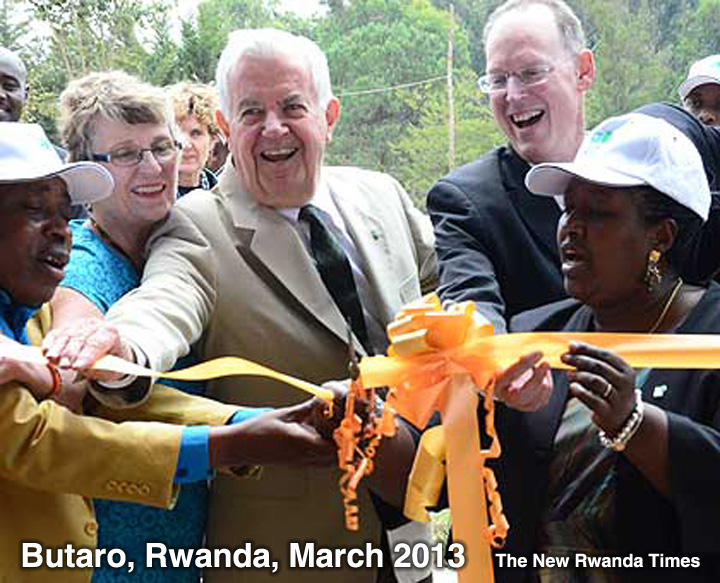

In addition to impacting life expectancy, the Center has had a positive effect on the local economy. Already, construction of the facility provided 161 jobs and training to local citizens. The facility is staffed primarily with Rwandan health professionals.
Cummings Foundation is pleased to work alongside Partners In Health to bring healthcare to an underserved population as a step toward transforming global health, one patient at a time.

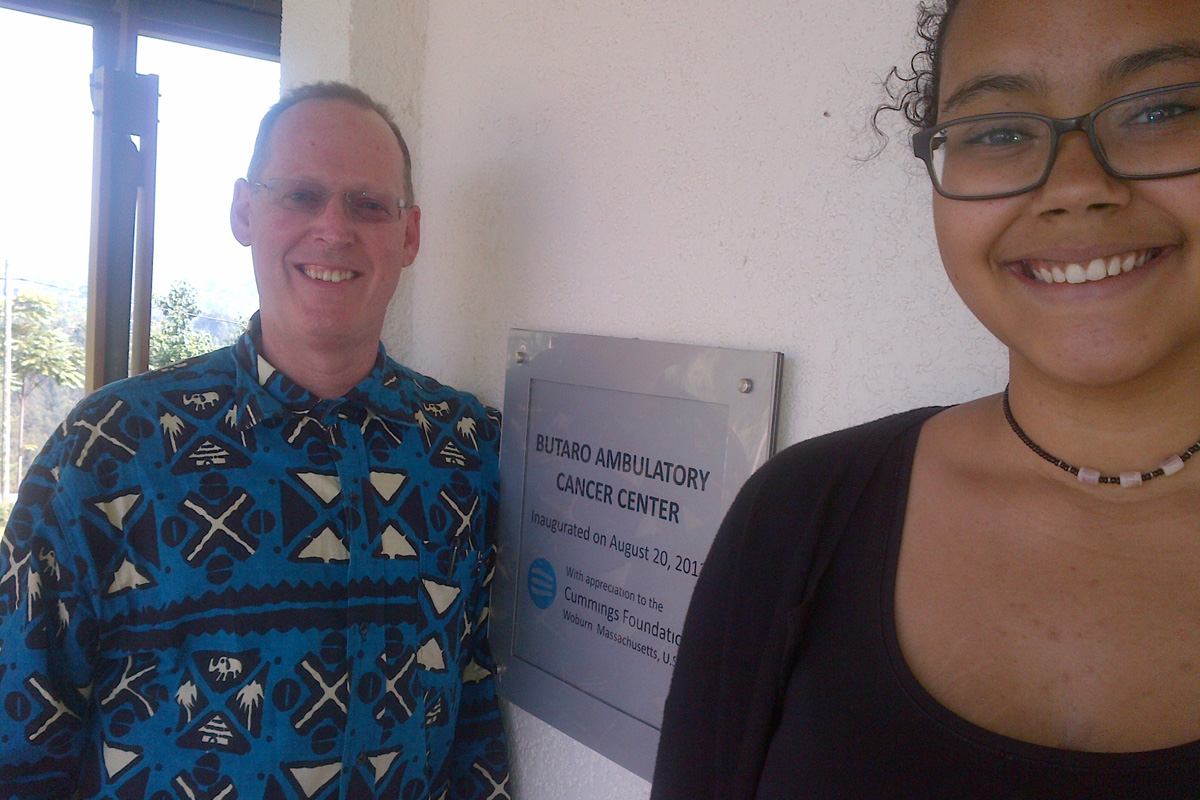
Dr. Paul Farmer, founder of Partners In Health, and his daughter Catherine at Butaro Ambulatory Cancer Center in summer 2014.
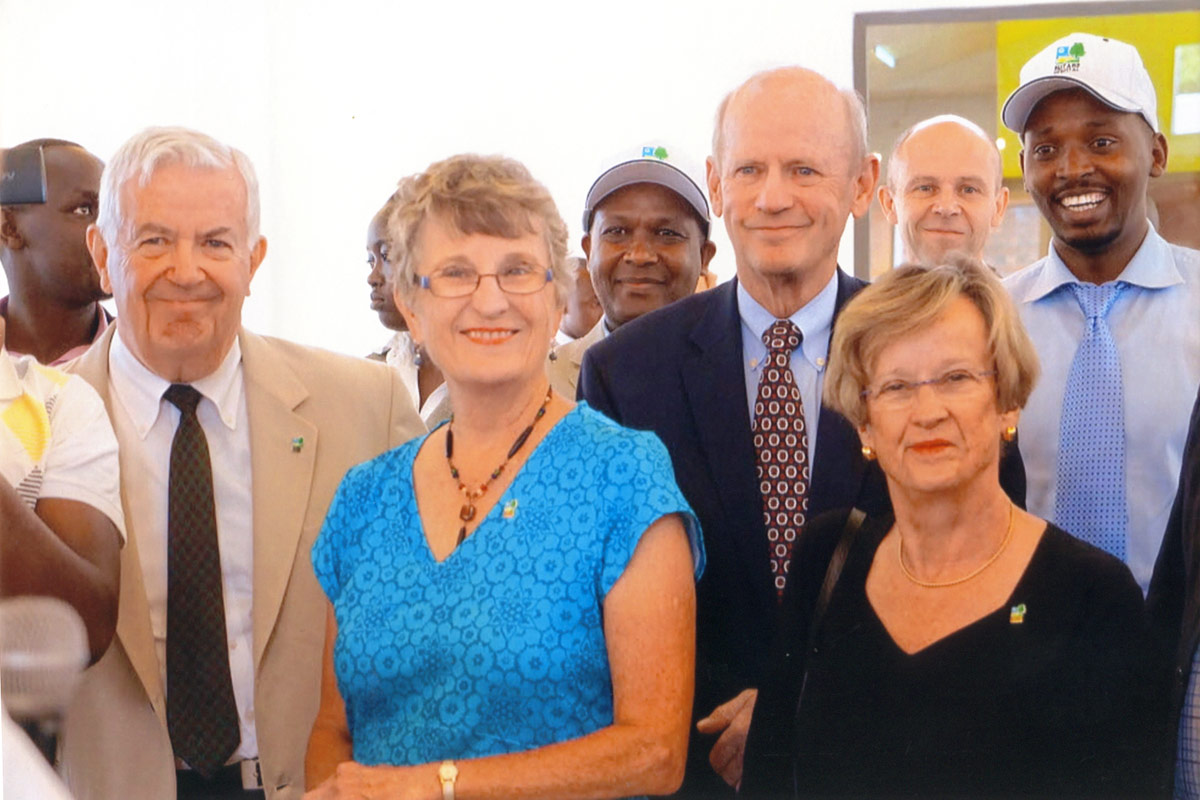
(front, left to right) Bill and Joyce Cummings and Arlan and Alice Fuller attended the August 20, 2013 dedication of Butaro Ambulatory Cancer Center.
Learn more:
Butaro Cancer Center, Designed by MASS Design Group
Architect Magazine, March 1, 2014
Tufts Cummings School of Veterinary Medicine

In addition to Cummings Foundation’s long term general interest in Cummings School, the Foundation is supporting the School’s specific efforts to combat the health threats posed by zoonotic illnesses, which are diseases that can be passed between animals and people. A significant global problem, nearly three-quarters of human diseases in the last 50 years have been zoonotic.
Through its Department of Infectious Disease and Global Health, and in partnership with U.S. Agency for International Development (USAID), the Cummings School has a significant presence in six east African countries. It is using a “one health” approach that combines human medicine, veterinary medicine, and public health to treat communities holistically.
In support of the Cummings School’s “one health” initiatives in Rwanda, Cummings Foundation awarded it a 2013 grant to establish a mobile veterinary clinic with on-site diagnostic capability. The School will also offer professional development training for veterinarians and para-veterinarians. Such services and expertise are vital to the country’s “One Cow per Family” initiative, as the European breeds of cattle being imported for this initiative demand a much higher level of veterinary services than can currently be provided in Rwanda.
Tufts University School of Dental Medicine (TUSDM)

Currently, Rwanda has 11 dentists, or one dentist per 800,000 people. While it fares better with dental technicians—one per 135,593 inhabitants—these ratios leave the vast majority of Rwandans lacking even the most basic oral healthcare. Pain, bleeding gums, and infections are rampant problems in many rural areas.
TUSDM has the interest, experience, and capacity to develop effective global oral health initiatives. For example, a Tufts project in Zambia, led by Dr. John P. Morgan, uses an effective model of collaboration between local communities, government, and academia to provide an improved oral health workforce and sustainable oral health infrastructure. With a 2013 grant from Cummings Foundation, TUSDM hopes to employ this model in an effort to improve the availability of oral healthcare in Rwanda.
Dr. Morgan and his colleagues hope to create a dental clinic at Butaro Hospital, a Partners in Health facility in rural Burera District. Through training programs, they aim to substantially increase the number of qualified oral health workers who can perform routine dental exams and procedures. Ultimately, the program’s goal is to integrate oral health into Rwanda’s overall health system.
Agahozo Shalom Youth Village
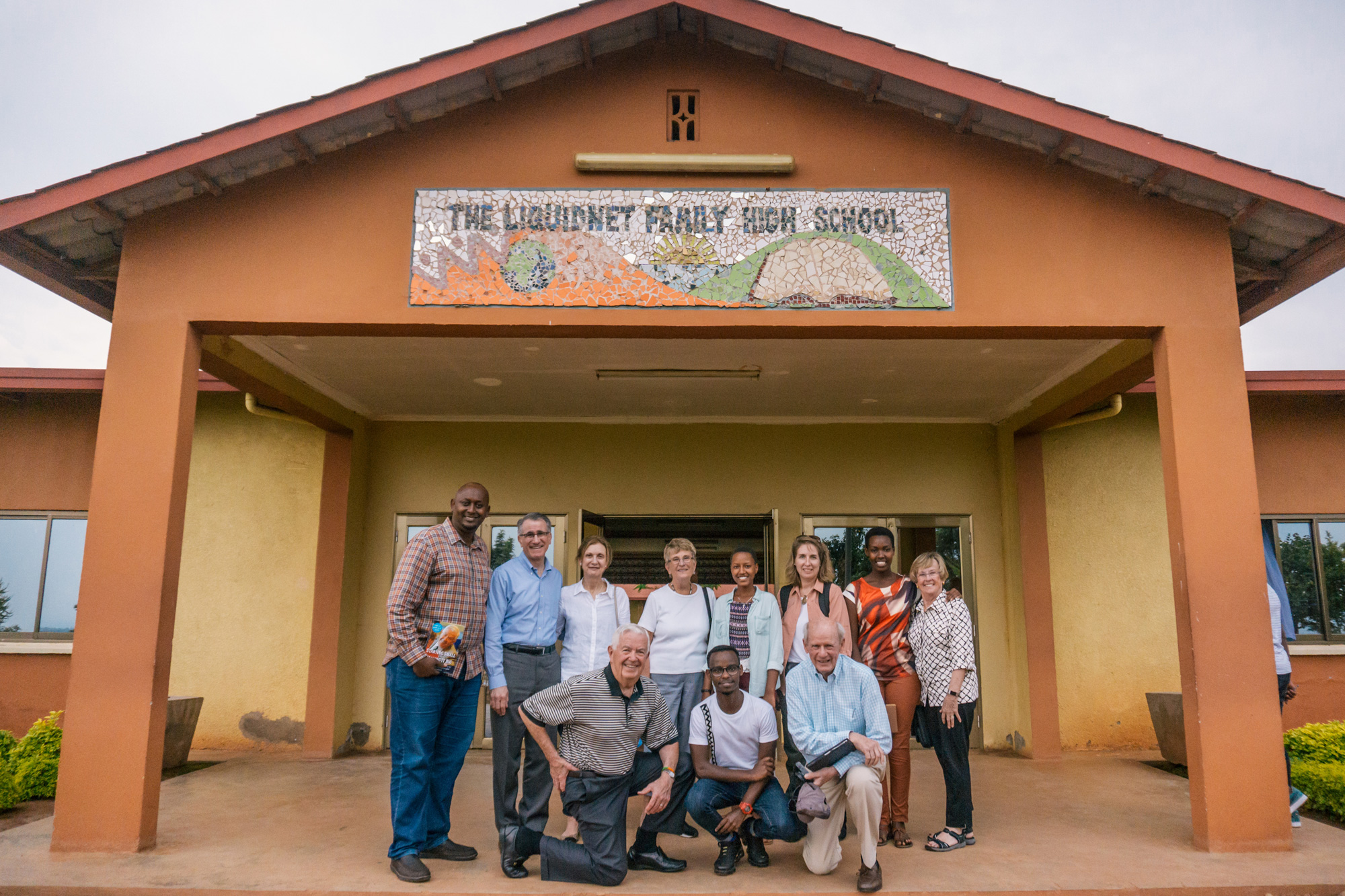
Agahozo-Shalom Youth Village (ASYV) is a residential community in rural Rwanda serving highly vulnerable youth, many of whom were orphaned during and after the genocide in 1994. The Village is designed to care for, protect, and nurture these young people, offering a place of hope where tears are dried (signified by the Kinyarwanda word agahozo) and where the aim is to live in peace (from Hebrew, shalom).
The ultimate goal of Agahozo-Shalom is to equip young people who have lived through great trauma to become healthy, self-sufficient, and engaged in the rebuilding of their nation. Cummings Foundation supports ASYV’s professional skills program, designed to provide students with the tools they need to enter the job market after they graduate and leave the Village.
The Foundation was delighted to help facilitate a connection between the 500-student school and Partners In Health. This international healthcare organization is now assisting ASYV with vaccinations and other health needs, and has hired several graduates for healthcare positions at its hospitals in Rwanda.
Founded in 2007, Agahozo-Shalom was conceived, founded, and largely funded by Anne Heyman, who died in a tragic equestrian accident in Wellington, Florida on January 31, 2014. By that time, ASYV, with all of the love and devotion Anne put into it, had already become a resounding success. If there was a shortcoming to be found, it was that there was only one ASYV, rather than schools like it all over Africa.
Shortly before her untimely death, Anne traveled to Salem State University with Joyce and Bill Cummings to meet with the directors of the university’s Center for Holocaust and Genocide Studies. Thanks to Anne’s special interest in encouraging a partnership, the new center incorporated a service-learning trip to ASYV in its curriculum. The first group of 11 Salem State University undergraduate and graduate students traveled to the village in June 2015, led by Professor Robert McAndrews. The experience was described as "unique and transformative."
Dr. Stephen Smith’s tribute, below, reflects so beautifully on the tremendous woman who, by age 52, had already accomplished so much more than most people might in a full lifetime.
Stephen D. Smith, Ph.D. is executive director of the USC Shoah Foundation, UNESCO Chair on Genocide Education, and USC Adjunct Professor of Religion.
Anne Heyman, in memoriam
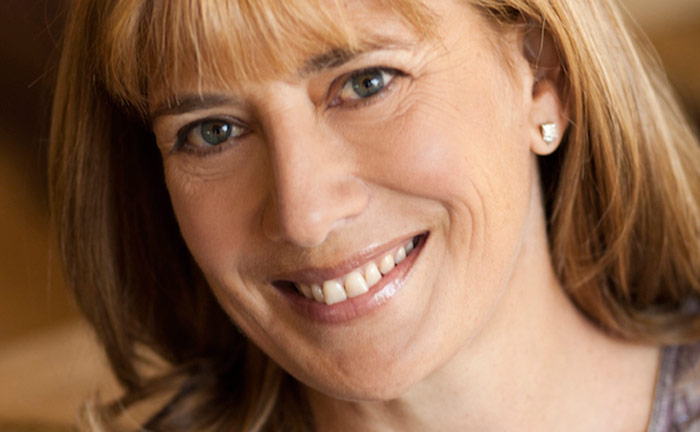
Anne Heyman, 52, the pioneering founder of Agahozo-Shalom Youth Village, a community for children orphaned during the 1994 Rwandan genocide, died in an equestrian accident on Friday, Feb.1 in Palm Beach, Florida. The South African-born Heyman modeled Agohozo on Israeli youth villages. It is now home to 500 children.
We live in times of deep turmoil, where hope is a rare commodity. Even among the most optimistic, creating meaning out of profound loss is hard fought. After genocide it takes vision to see the possibility of life again, it takes soul to build a home and give an education—a foundation for future—to children robbed of parents. It also takes a woman to know how to create a family of orphans. One with family units, homes and mothers at the heart of its community.
Agohozo Shalom is a haven in Rwanda—it is village, school, and kibbutz, all rolled into one. When you stand in the middle of the village, hills and lakes stretch as far as the eye can see, silence, blue skies and a farmer across the valley. Then the lunch time bell rings and four hundred beautifully dressed hungry high schoolers stream down the hill and into the cavernous dining room - everyone of them is an orphan, every one of them is also literate and on track to University or vocational training.
The dinner hall buzzes and clatters as all four hundred students eat in one sitting on long benches. I am perched next to my travel companion, Holocaust survivor Renee Firestone, sandwiched between bright eyed, ravenous kids, keen to practice their English. Renee turned to me and said "Do you know what it takes to nurture these orphans into the human beings they are today? The woman that did this truly deserves the Nobel Prize!"
Anne Heyman had the stillness of a mill pond, the zeal of a prophet, the soul of a mother. When first you met her, her understated attire, the simple language she chose, the sincerity of her tone, all belied the woman of steel behind her fair facade. She talked about 'The Village', as she called the project she founded in Rwanda, as if it really were the neighborhood, of the same name, just a few blocks away from us in lower Manhattan. She traveled to Rwanda like it was no further than Tribeca. She had to be there, among the people she loved. She was drawn there and they filled her soul.
Tzedakah is a well practiced tradition within the Jewish world, which has become increasingly equated with the word charity, though its real sense is based on its root word 'righteous' - working to create a just, or fairer world. In recent years Anne Heyman brought us back to its meaning in quite remarkable ways. She took the words 'social action' ever so seriously, taking action and personally creating change in a society.
Her philanthropy was true to the definition of the term itself - she really had a 'love of people' which far transcended the transactional nature of giving charity. Her philanthropy began with seeing the true potential in everyone. That is why she was not simply supporting orphans in Rwanda because there was a need, but because she believed in them as people.
Anne Heyman used the financial resources she had at her disposal with generosity that far exceeded the call of duty. But the real contribution she made was the complete giving of herself to others, always in the field (often literally), creating life from dirt, value from waste. No amount of money buys values. She not only bought a hill and then built a community on it. She needed electricity, so she built the largest solar plant in Sub-saharan Africa - so that the rest of Rwanda would get power too. She changed the meter on philanthropy from cash to commitment, and proved it can go further than you could ever imagine.
At times I worried for Anne. She was so far ahead, she seemed alone. Many knew about her work, she was lauded for her courage and thanked for her leadership, but few really understand what she was doing on their behalf. How brave and lonely it could be. I saw her tearful at times. I also saw pure determination as she knew social values happen when change takes place—and create change she did. I also saw the joy she expressed that can only come with one hundred graduates, all of whom had no hope, leaving Agohozo Shalom with the knowledge that are just as valuable as everyone else in this world, equipped and self reliant.
The great Jewish thinker Maimonides identified eight levels of Tzedakah, the highest being to enable others to be self reliant. Agohozo Shalom Youth Village exemplified the highest form of philanthropy, borne out of justice, fairness, love of your fellow human beings, whoever they are, wherever they are. It is a beacon of Jewish values in what was the heart of darkness.
Anne Heyman gave a gift to the world that will always be with us.